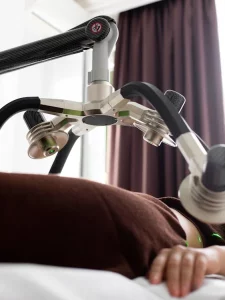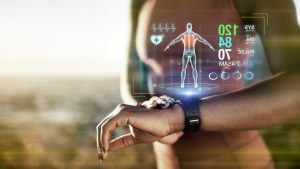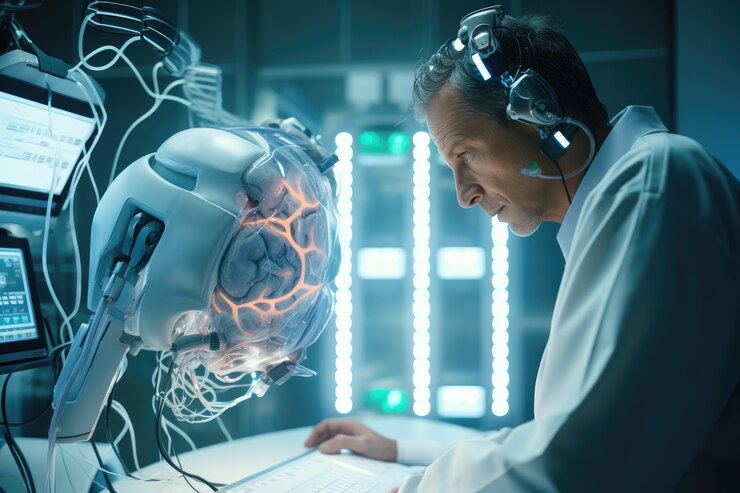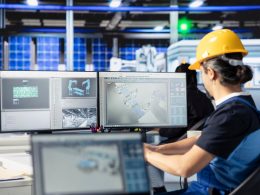Healthcare technology, or healthtech, has rapidly emerged as one of the most transformative forces in the medical industry. It includes the use of cutting-edge digital tools, software, and innovations to enhance healthcare services, improve patient outcomes, and optimize operational efficiency. From AI-assisted diagnostics and robotic surgeries to wearable devices and telemedicine, healthtech is revolutionizing the way healthcare is delivered.
This article explores some of the most significant advancements in healthcare tech, including its benefits, applications, and examples. We will also look at how leading healthtech companies are contributing to the evolution of healthcare systems worldwide.
The Role of Healthcare Technology in Modern Medicine
Healthcare technology refers to the integration of various digital tools, applications, and innovations in the healthcare industry. It encompasses a broad range of technologies used in diagnosing, treating, and managing medical conditions. These technologies aim to improve patient outcomes, reduce operational costs, and enhance the overall efficiency of healthcare systems.
Today, healthcare professionals rely on advanced tech tools for everything from administrative tasks to complex surgeries. Hospitals use AI-driven software to streamline patient admissions, predict peak busy hours, and optimize staff schedules. Meanwhile, robotic systems are assisting surgeons in performing minimally invasive procedures with unprecedented precision.
The Expanding Role of AI in Healthcare

Artificial Intelligence (AI) is one of the most impactful technologies in healthcare today. It is being used across various healthcare fields, from diagnostics and treatment recommendations to patient monitoring and administrative efficiency.
AI in Diagnostics
AI has made diagnostic procedures faster and more accurate by analyzing vast amounts of medical data in real-time. By using machine learning algorithms, AI can sift through patient records, medical images, and research data to detect patterns that are often missed by human doctors.
Example: IBM Watson Health is a prime example of AI in healthcare. It helps oncologists diagnose and create personalized treatment plans for cancer patients by analyzing thousands of medical research papers, clinical trials, and patient records in seconds. Another example is Zebra Medical Vision, an AI-powered software that interprets medical imaging scans to identify diseases such as breast cancer, liver disease, and cardiovascular conditions.
Benefits:
- Faster and more accurate diagnosis
- Personalized treatment plans based on patient-specific data
- Reduced diagnostic errors, leading to improved patient outcomes
AI in Drug Development
The pharmaceutical industry is using AI to accelerate drug discovery and development. AI algorithms can analyze large datasets of chemical compounds and clinical trials to predict the effectiveness of new drugs. This not only reduces the time and cost of developing new treatments but also identifies more targeted therapies for patients.
Example: Atomwise uses AI to predict which molecules will have the best therapeutic effects in the early stages of drug discovery. AI models help researchers identify potential drug candidates much faster than traditional methods, reducing the trial-and-error process that often slows down drug development.
Surgical Robots: Revolutionizing Surgery
Surgical robots are among the most remarkable advancements in healthcare tech, allowing for minimally invasive surgeries that reduce recovery time and improve precision.
Surgical Robots in Action
The Da Vinci Surgical System is the most well-known robotic surgical platform. It assists surgeons in performing complex procedures by providing high-definition 3D visualization and robotic arms that can execute delicate movements with extreme precision. This allows for smaller incisions, less tissue damage, and faster recovery times for patients.
Example: The Da Vinci Surgical System is widely used in surgeries such as prostatectomies, gynecologic surgeries, and cardiac valve repairs. In addition, Mazor Robotics is a system used in spinal surgeries that improves the precision of placing screws and implants, reducing complications and improving patient outcomes.
Benefits:
-
- Reduced recovery times due to minimally invasive procedures
- Enhanced precision during surgeries, reducing the risk of errors
- Shorter hospital stays and lower healthcare costs for patients
Augmented Reality in Surgery
Apart from robotic systems, augmented reality (AR) is being used to assist surgeons in visualizing complex anatomical structures. AR provides real-time, interactive overlays that help surgeons navigate difficult procedures more accurately.
Example: Microsoft HoloLens is an AR tool that surgeons are using to visualize 3D images of a patient’s anatomy before and during surgery. This enhances decision-making and improves surgical accuracy, particularly in complex procedures such as brain surgeries.
Wearable Technology in Healthcare
Wearable devices have become a crucial part of the healthcare landscape. These devices monitor vital signs, track fitness levels, and even detect abnormalities that could signal serious health issues. By providing real-time data, wearable technology empowers individuals to take control of their health while enabling healthcare professionals to monitor patients remotely.
Smartwatches and Fitness Trackers

Wearable devices such as the Apple Watch and Fitbit can track heart rate, activity levels, sleep patterns, and even detect irregular heart rhythms, such as atrial fibrillation. This information is invaluable for both users and healthcare providers, as it helps in the early detection of potential health issues.
Example: The Apple Watch Series 7 includes an electrocardiogram (ECG) feature that detects heart abnormalities. Similarly, AliveCor’s KardiaMobile is a portable device that provides ECG readings, allowing users to monitor their heart health from anywhere.
Benefits:
- Real-time health monitoring
- Early detection of cardiovascular issues
- Encourages proactive health management and lifestyle changes
Wearable Sensors for Chronic Conditions
Wearable devices are particularly beneficial for patients with chronic conditions such as diabetes and hypertension. For example, continuous glucose monitors (CGMs) allow diabetics to track their blood sugar levels without needing to constantly prick their fingers.
Example: Dexcom produces continuous glucose monitors that provide real-time blood sugar readings. This data can be shared with healthcare providers, enabling better management of diabetes and reducing the risk of complications such as heart disease and kidney failure.
Telemedicine and Virtual Healthcare
Telemedicine has emerged as a critical component of healthcare technology, particularly during the COVID-19 pandemic. It allows patients to receive medical care without the need for physical visits, saving time, costs, and resources for both patients and healthcare providers.
Virtual Consultations
Telemedicine platforms allow patients to connect with doctors and specialists through video calls, phone consultations, or chat-based systems. This has expanded access to healthcare services, especially for individuals living in remote or underserved areas.
Example: Teladoc Health offers virtual health consultations across various specialties, from primary care to mental health services. Another popular platform, Doctor on Demand, provides patients with on-demand access to licensed medical professionals for urgent care, mental health support, and preventive health services.
Benefits:
- Increased access to healthcare for patients in remote locations
- Reduced need for in-person visits, saving time and costs
- Enhanced patient satisfaction and engagement with virtual care options
Remote Patient Monitoring
Telemedicine also enables remote patient monitoring, where healthcare providers can track a patient’s health metrics through connected devices. This is particularly useful for managing chronic conditions such as hypertension, heart disease, and diabetes.
Example: Livongo is a remote monitoring system that provides patients with connected devices to track their blood pressure, glucose levels, and weight. Healthcare providers can review the data and intervene early if there are any concerning trends.
The Importance of Diagnostics Tools in Healthcare
AI-powered diagnostic tools have significantly improved the accuracy of diagnoses, leading to earlier detection and treatment of life-threatening diseases such as cancer, heart disease, and diabetes.
AI in Diagnostics
By analyzing medical images, lab results, and genetic data, AI systems can detect diseases with greater accuracy than traditional methods. These tools help doctors make more informed decisions, reduce diagnostic errors, and provide better patient outcomes.
Example: Google’s DeepMind AI has been used to detect eye diseases by analyzing retinal scans. In clinical trials, DeepMind’s AI achieved diagnostic accuracy on par with human specialists. Similarly, IDx-DR, an FDA-approved AI-based diagnostic system, detects diabetic retinopathy by analyzing retinal images.
Benefits:
- Early detection of diseases such as cancer, heart disease, and diabetes
- Reduced diagnostic errors, leading to improved patient outcomes
- Faster decision-making for treatment plans
Leading Healthcare Technology Companies
Several healthtech companies are driving innovation in the medical industry. Their contributions span medical imaging, wearable technology, robotic surgery, and diagnostics. Some of the most notable companies include Siemens Healthineers, Medtronic, and GE Healthcare.
Siemens Healthineers
Siemens Healthineers is a global leader in medical imaging and diagnostic solutions. Their advanced imaging systems assist healthcare professionals in diagnosing a wide range of medical conditions, including cardiovascular diseases, cancer, and neurological disorders.
Example: Siemens Healthineers’ MAGNETOM Altea is an advanced MRI scanner that provides high-quality imaging with a faster scan time, improving patient comfort and diagnostic accuracy.
Medtronic
Medtronic is renowned for its innovations in surgical tools, particularly in minimally invasive surgery and cardiovascular care. Their products, such as pacemakers and insulin pumps, have transformed the management of chronic conditions.
Example: Medtronic’s Micra™ Transcatheter Pacing System is the world’s smallest pacemaker. It delivers electrical impulses to the heart through a minimally invasive procedure, reducing recovery time and patient discomfort.
Analysis Table: Impact of Healthcare Tech on the Medical Industry
| Technology | Example Product/System | Benefits | Applications |
|---|---|---|---|
| AI in Healthcare | IBM Watson Health | Faster diagnosis, personalized treatments | Diagnostics, cancer treatment |
| Surgical Robots | Da Vinci Surgical System | Minimally invasive surgeries, reduced recovery times | Cardiac surgery, prostatectomy |
| Wearable Technology | Apple Watch Series 7 | Continuous health monitoring, early issue detection | Cardiovascular health, fitness tracking |
| Telemedicine | Teladoc Health, Doctor on Demand | Virtual consultations, remote monitoring | Primary care, mental health |
| Diagnostics Tools | Google DeepMind AI, IDx-DR | Early detection, reduced diagnostic errors | Eye disease detection, cancer diagnosis |
| Healthtech Companies | Siemens Healthineers, Medtronic | Advanced imaging, smart medical devices | Imaging, surgical devices |
Conclusion
Healthcare technology is transforming the healthcare industry by providing advanced tools that improve diagnostics, treatment, and patient care. From AI and wearable devices to surgical robots and telemedicine platforms, healthcare tech is delivering significant benefits such as improved accuracy, enhanced patient satisfaction, and reduced healthcare costs. The future of healthcare lies in continued innovation, and the industry will continue to evolve as technology advances further.












